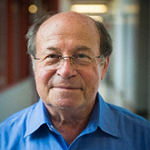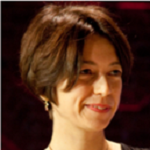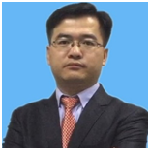Home - KEYNOTE SPEAKERS

Yeshaiahu (Shaya) Fainman is Cymer Chair and Distinguished Professor in Electrical and Computer Engineering (ECE) at the University of California, San Diego (UCSD). He received the Ph. D. from Technion-Israel Institute of Technology in 1983. He is directing research of the Ultrafast and Nanoscale Optics group at UCSD and made significant contributions to near field optical phenomena, inhomogeneous and meta-materials, nanophotonics and plasmonics, and non-conventional imaging. His current research interests are in near field optical science and technology with applications targeting information technologies and biomedical sensing. He contributed over 320 manuscripts in peer review journals and over 540 conference presentations and conference proceedings. He is a Fellow of the OSA, IEEE, SPIE, and a recipient of the Miriam and Aharon Gutvirt Prize, Lady Davis Fellowship, Brown Award, SPIE Gabor Award, OSA Emmett N. Leith Medal, OSA Joseph Fraunhofer Award/Robert M. Burley Prize and OPTICA (former OSA) Nick Holonyak Jr Award.
Concita Sibilia received her doctoral degree with honours in Physics from the University of Roma “La Sapienza”. She is currently Head of the Nonlinear Optical Laboratory at the Department of Basic and Applied Science (SBAI) at the Engineering Faculty of the University of Roma. She is full professor in Physics since 2000. She is Director of the II level Master in “Optics and Quantum Information” at La Sapienza. The main research interests are in the field of optics, nonlinear optics at the nanoscale, photonic crystals, metamaterials, plasmonics. She is responsible of many national and international projects. She organized many Conferences supported by the EOS, OSA. She is author of more than 500 papers, with more than 80 invited presentations at International Conferences. She is fellow of the American Optical Society and member of the European Physical Society. She is in the board of COST MP1403 (Nanoscale Quantum Optics) and in the editorial board may international journals.
Mihaela C. Stefan received her B.S. in Chemical Engineering and Ph.D. in Chemistry from Politehnica University Bucharest, Romania. She worked as a Postdoctoral Researcher in Matyjaszewski’s group at Carnegie Mellon University from 2002 to 2003. She also worked as a Research Scientist in Richard D. McCullough's group at Carnegie Mellon University on the synthesis of block copolymers containing semiconducting polythiophenes. She joined the Department of Chemistry and Biochemistry at the University of Texas at Dallas in 2007, and she is currently a Eugene McDermott Professor and Department Head. She received the NSF Career Award in 2010, the NS&M Outstanding Teacher Award in 2009 and 2017, the Inclusive Teaching Diversity Award in 2012, the President’s Teaching Excellence Award in 2014, Provost’s Award for Faculty Excellence in Undergraduate Research Mentoring in 2015, and Provost’s Award for Faculty Excellence in Graduate Research Mentoring in 2021. She also received the Wilfred T. Doherty Award from the Dallas Forth Worth Local Section of the American Chemical Society in 2021. Her research group is developing novel organic semiconductors for organic electronics, biodegradable and biocompatible polymers for drug delivery applications, and rare novel catalysts for polymerization of dienes and cyclic esters. At the University of Texas at Dallas, she supervised 36 graduate students and 25 Ph.D. students graduated with a Ph.D. in Chemistry under her supervision. She also mentored ~130 undergraduate students who worked in her research lab on various projects. https://scholar.google.com/citations?user=ibS18zAAAAAJ&hl=en https://profiles.utdallas.edu/mihaela https://personal.utdallas.edu/~mci071000/
Prof John Ballato is a Professor of Materials Science and Engineering at Clemson University (Clemson, SC, USA) where he also holds the J. E. Sirrine Endowed Chair in Optical Fiber. He has published over 500 technical papers, primarily on optical fiber materials and properties. Among numerous other honors, Ballato is a Fellow of the American Association for the Advancement of Science (AAAS), the American Physical Society (APS), the Institute of Electrical and Electronics Engineers (IEEE), Optica (formerly the Optical Society of America, OSA), the International Society of Optical Engineering (SPIE), and the American Ceramic Society (ACerS), as well as an elected member of the U.S. National Academy of Inventors.
Professor Benfeng Bai received his B.Sc. degree and Ph.D degree in Optical Engineering from Tsinghua University, China, in 2001 and 2006, respectively. From 2006 to 2009, he was a post-doctoral fellow at the Department of Physics and Mathematics in University of Joensuu, Finland. In 2009, he became a faculty member in the Department of Precision Instrument at Tsinghua University. He is now the principal investigator of the Nanophotonics Group with research emphases on Advanced Nano-devices, Nano-fabrication and Nano-measurement based on Near-field Optics to tackle the most urgent academic and engineering challenges and demands of the nation and the academic society. His main research contributions are in the following three aspects: (1) Advanced functional nano-devices based on near-field optics, by developing theories and experimental tools for constructing meta-devices with advanced functionalities; (2) Advanced nano-fabrication based on near-field light-matter interaction, by developing techniques for manufacturing key optical elements for high precision metrology systems such as extended area blackbodies and micro-cavity optical Kerr frequency combs; (3) Advanced near-field microscopy for nanomaterials and nanodevices characterization, by developing new principles, methods and instrumentation of near-field microscopy to address the needs of super-resolution characterization of optoelectronic properties and the detection of various nano-defects in functional nanodevices and various low-dimensional materials that are important basis materials for next-generation information and quantum applications. So far, Professor Bai has published more than 100 research papers in international journals including Nature Communications, Light: Sci. & Appl., Nano Letters, Advanced Functional Materials, Laser & Photonics Reviews, Small, etc., has given more than 20 invited presentations in international conferences, has acted as the chairs or main organizers of more than 10 international conferences, has delivered 5 short courses in international workshops and summer schools, and has been granted more than 30 international and Chinese patents. His works are widely cited, as indicated by his h-index of 32 and i10-index of 65. The total citations of his papers are 7400+ (and 4500+ since 2018), according to Google Scholar. As the responsible leader, he has led more than 10 research projects funded by the major funding agencies in China, including the Ministry of Science and Technology of China and the National Natural Science Foundation of China. He is currently serving as one of the coordinators of the Sino-French Optoelectronics and Photonics International Research Network (PHOTONET) consisting of 8 Chinese partner universities and 7 French partner universities, a board member of the National Technical Committee on Standardization of Nanotechnology of China, a board member of the Instrument Group of Micro and Nano Professional Committee of the Chinese Society for Optical Engineering (CSOE), a board member of the Powder Technology Association of Beijing, and a board member of the Metamaterial Branch of Chinese Materials Research Society. During 2014-2020, he has acted as a Topical Editor for Optics Letters, an Optica (formally OSA) journal. He has won the Award of Jin Guofan Young Scholar issued by the China Instrument and Control Society in 2011 and SPIE Community Champion issued by SPIE in 2022.
Professor Salman Noach received his PHD in physics at 2003 from the Hebrew University Jerusalem ISRAEL. After few years of industrial experience, he returned back to academy at 2007, as a faculty member at the electro-optics department at Jerusalem College of Technology. There he founded the Solid State Lasers Laboratory. The lab is mainly engaged in applied research and development of CW and pulsed solid-state lasers, nonlinear optics, Raman wavelength shifting and Optical amplifiers in the SWIR and mid IR range. The results of the lab research were the object of 40 publications in high-ranked journals in the optics and laser community and two patents. He is a senior member of OPTICA and member of SPIE.

Katia Gallo holds Ph.D. degrees in Electronic Engineering (Italy) and Condensed Matter Physics (France). She is Professor of Applied Physics at KTH, the Royal Institute of Technology in Sweden, where she leads the Nonlinear and Quantum Photonics group, whose research activity spans theory, technology and experiments of nonlinear optical interactions in periodically poled ferroelectrics, photonic crystals and integrated all-optical devices, with a focus on quantum photonics and optical signal processing. She has been Director of the VR “Optical Quantum Sensing” Research Environment and currently leads the excellence program in Quantum Communication of the Wallenberg Centre for Quantum Technology as well as the National Quantum Communication Infrastructure in Sweden (NQCIS). Her research interests include nanotechnology, nonlinear optics and integrated photonics, ferroelectric material science, optical telecommunications and quantum photonics. She was the recipient of the Centre and South Italy IEEE Student Award in Electronic Engineering (1996), twice EU Marie Curie fellows (1998, 2009), Leverhulme Trust Early Career Fellow (2005), London Technology Network Business Fellow (2006) and Swedish Research Council Special Research Fellow for the discipline “Semiconductor physics, electronics, electrical engineering and photonics” (2011).
Prof. Andrew Wing On Poon received his B.A. (Hons.) degree from The University of Chicago, Illinois, USA in 1995, and his M. Phil and Ph. D. degrees from Yale University, Connecticut, USA, in 1998 and 2001, all in Physics. In 2001, he joined the Department of Electronic and Computer Engineering, The Hong Kong University of Science and Technology, as an assistant professor. Since then, he has risen through the ranks and is now a professor and Department Head. Since 2002, Prof. Poon and his students at HKUST have been spearheading diverse research directions in optical microcavities leveraging wafer-level silicon nanofabrication processes. The Poon group is among the early players of the now global silicon photonics community in academia and industry. He is a Senior Editor of the IEEE Photonics Technology Letters. He served as a Guest Editor of the IEEE Journal of Selected Topics in Quantum Electronics (JSTQE) on Silicon Photonics 2016. He is the General Chair of the 6th International Workshop on Microcavities and Their Applications (WOMA) 2022, Hong Kong. He has published one co-edited book (World Scientific 2011). He is a Fellow of Optica.
Heinz-S. Kitzerow has studied liquid crystals, i. e. ordered fluids, during the last four decades. He received his diploma in chemistry in the year 1983, his Ph. D. degree in 1989 and his postdoctoral lecture qualification in 1995 at the Technical University Berlin (Germany). After research visits in Orsay (France) and Honolulu (HI, USA), he became Professor of Physical Chemistry at Paderborn University (Germany) in 1998. H.-S. K. served as secretary of the International Liquid Crystal Society (2006–2014) and chairman of the German Liquid Crystal Society (2019-2023) and is a regional editor of the journal Molecular Crystals and Liquid Crystals (since 2012). Recent research of his team was focussed on the preparation of nanoparticles and the interaction between nanostructures and liquid crystals with regard to potential applications in optoelectronics and photonics.
Kam Sing Wong received the BSc (Hons.) degree in physics from the University of London in 1983 and the D. Phil degree in solid-state physics from the University of Oxford in 1987. He joined the Physics Department of Hong Kong University of Science and Technology (HKUST) in 1991 as the founding faculty and he is now a professor at the department. His main research interests include ultrafast lasers, nonlinear optics, time-resolved spectroscopy, semiconductor and polymer physics, photonic crystal and plasmonics. He has published over 310 peer-reviewed publications with total citations over 21000 and h-index of 80. Prof. Wong was the President of the Physical Society of Hong Kong (2007-2009). He has served as the Conference Chair for the 4th Asian Conference on Ultrafast Phenomena (2006) and the Conference co-Chair for the 11th International Conference on Optical Probes of Conjugated Polymers and Organic Nanostructures 2015. Currently, he is serving in the conference committee of ‘Ultrafast Phenomena and Nanophotonics’, part of Photonics West conference.
Muhammad Nadeem Akram received Ph.D. degree in Photonics and microwave engineering from Royal Institute of Technology, Stockholm, Sweden, in 2005. He is currently a Professor of Photonics at the University of South-eastern Norway, Borre, Norway. His research work has been mainly concerned with QW lasers, imaging optics, speckle reduction, computational imaging and diffractive optics. He is deputy editor in Applied Optics journal, OSA.
Prof. Feng QI did his bachelor’s study in Zhejiang University, China and got master and PhD degrees from Katholieke Universiteit Leuven, Belgium in 2005 and 2011, respectively. Since 2011, he worked in RIKEN, Japan; Goethe University, Germany and University of Birmingham, UK. In 2015, he joined Shenyang Institute of Automation as a professor and founded the THz Imaging Laboratory. He has served Technical Program Committee and sessions chairs for several international conferences including IRMMW-THz, ICC, GSMM, etc.. He got the student grant in European Radar Conference 2009, and Best Paper Award in Global Symposium on Millimeter Waves, 2014. In 2013, he attended the first Global Young Scientist Summit as a representative of RIKEN. He has publish more than 160 papers in interational journals and conferences. He has given three plenary talks and several invited talks in international conferences. Now his interests include microwave, laser, and accoustics with corresponding research going on in his group, aiming at imaging and sensing applications.

CAIMING SUN received the B.S. and M.S. degrees from Beijing Normal University, Beijing, China, in 2002 and 2005, respectively. He received the Ph.D. degree in electronic engineering from the Chinese University of Hong Kong (CUHK), Hong Kong, China, in 2008. He is currently a researcher at Institute of Robotics and Intelligent Manufacturing (IRIM), the Chinese University of Hong Kong (CUHK), Shenzhen, China. His research interests include Nanophotonic Phased Array and Si Photonics. He has published more than 50 papers in referred international conferences and journals, and granted over 20 patents. He is a senior member of IEEE Photonics Society/ Robotics and Automation Society.
Kenneth K. Y. Wong received combined B.E. (1st class honor with medal award) degree in electrical engineering and B. S. degree in physics from the University of Queensland, Brisbane, Australia, in 1997. He received the M.S. degree in 1998 and the Ph.D. degree in 2003, both in electrical engineering at Stanford University. He was a member of the Photonics and Networking Research Laboratory at Stanford University. His research field included novel optical generation, photonic parametric processing, ultrafast optical communications and imaging (spectroscopy, microscopy, and tomography). He is author or coauthor of over 450 journal and conference papers. He worked in Hewlett-Packard Laboratories as research engineer and contributed in projects included parallel optics and VCSEL in 1998-99. He also worked as independent consultant in Innovation CORE (A Sumitomo Electric Company), CA, in 2004. He is currently the Head and Professor in the Department of Electrical and Electronic Engineering in the University of Hong Kong, where he won the Best Teacher Award 2005-06, Outstanding Young Researcher Award 2008-09, Outstanding Teaching Award 2012-13 (Team), and Outstanding Research Student Supervisor Award 2018-19. He served at Publications Committee of SPIE, as an Associate Editor of IEEE Photonics Technology Letters and Optica (formerly OSA) Optics Express. During the 2009-10 academic year, he joined the Empower Teacher Program, organized by department of Electrical Engineering and Computer Science (EECS) at the Massachusetts Institute of Technology (MIT) by co-teaching a sophomore course and living in a graduate residence. He was the recipient of Optica New Focus Student Award and IEEE/LEOS Graduate Student Fellowship, both in 2003. He is a senior member of the IEEE (Photonics Society) and recently selected as the 2022 SPIE and 2023 Optica Fellows. He is also serving as the Chair of IEEE Hong Kong Section.